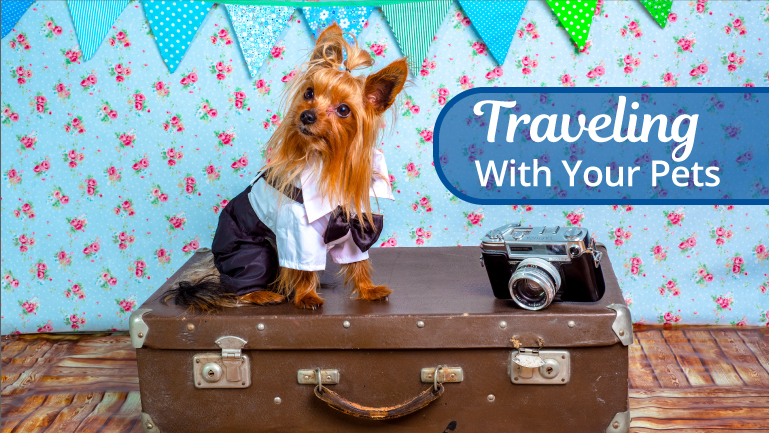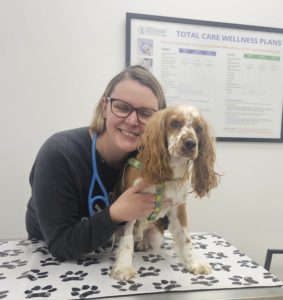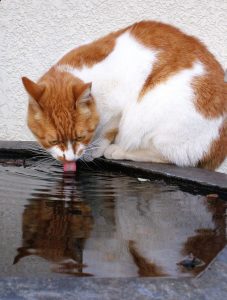Getting Your Pet Ready for Travel: Tips and Immunizations
Before Traveling
Is it a good idea?: Before traveling, you should first ask yourself if it is a good idea to bring your pet on your trip. While it’s natural to want your pet to be a part of adventures, some pets may not be suited for travel. If your pet is sick or injured, or has an anxious temperament, then it may be in your pet’s best interest to leave them at home with a trusted caretaker.
Immunizations/Vaccines 1: If you decide that your pet is fit for travel, then remember that each trip should have a healthy start. Begin with a visit to your vet to make sure that your pet is up-to-date with all necessary vaccines and has a clean bill of health. You never know what your pet will encounter in a new location, so make sure that they are as protected as possible. Below is the list of ASPCA recommendations of core vaccines for pets:
For Dogs: Vaccines for canine parvovirus, distemper, canine hepatitis, and rabies. (Non-core, but recommended vaccines include: Bordetella bronchiseptica, Borrelia burgdorferi, Influenza, and Leptospira bacteria)
For Cats: Vaccines for panleukopenia (feline distemper), feline calicivirus, feline herpesvirus type I (rhinotracheitis), and rabies. (Non-core, but recommended vaccines include: feline leukemia virus, Bordetella, Chlamydophila felis, and feline I immunodeficiency virus)
Your vet can also recommend any additional vaccines that may be necessary for the specific location you are traveling too. Be sure to keep a record of these vaccines with you on your travels.
Practice restraint 2: No matter what form of transportation, your pet will likely be spending a lot of time inside a carrier. A month before you travel, practice putting your pet in the carrier to make sure they are comfortable with it. This will reduce the amount of stress your pet experiences while traveling. Have a plan: How often can you let your pet have a break? What are you going to do if your pet is lost or injured? Do you have all the supplies your pet needs for the entire trip? These are all questions that should be answered in your travel plan.
For Flying
It is generally not recommended to fly with your pets unless it is absolutely necessary; it tends to be a stressful experience for them as it does not give them many opportunities for breaks. For some pets, flying can even be dangerous. Brachycephalic pets, or pets with short heads and muzzles, like Pugs, Boxers, Bulldogs, or Persian cats, should not be taken on a flight as their short nasal passages leave them vulnerable to oxygen deprivation and stroke 3. If you do decide to fly with your pets, make sure to weigh all the risks and follow the steps below to minimize stress and keep your pets as safe as possible.
The Right Flight: Keep in mind that not all flights are the same. When you are flying with pets, it is best to pick a flight that will minimize pet stress. An ideal flight would be a direct, non-peak flight 4. A direct flight will prevent the stress caused by layover time and will reduce the time your pet spends in the carrier. A non-peak flight typically means less passengers and more cabin room 5. Suffice it to say, traveling by air with your pets during any busy seasons (especially around the holidays) is not recommended. You want to be sure that you and your pet are on the same flight and, if possible, keep your pet in the cabin with you. If traveling during summer or winter, pick a flight that will accommodate temperature extremes (especially if your pet is traveling below the cabin). Some airlines may even ban pet travel during these months so as to not subject pets to these extreme temperatures 5.
USDA Approved Carrier 4: While most airlines will accept both hard-sided and soft- sided carriers, some may be particular about the brand of carrier. Once you have selected the best pet carrier, be sure to start early when familiarizing your pet with it. Several weeks before the trip, practice putting your pet in the carrier so that they will be acclimated to being inside by the time of the trip.
Prepare your pet 5: Before boarding your flight, there are steps to be taken. This includes clipping your pet’s nails to protect them from hooking to the carrier. Avoid feeding your pet four to six hours before flying (though small amounts of water are allowed). Don’t administer tranquilizers to your pet unless they have been prescribed by your veterinarian. All of this will help your pet avoid injury and keep them healthy throughout the flight.
Proper Identification 5: One of the biggest fears that pet parents face is what to do if their pet gets lost. In order to prevent this, make sure there is a travel label (including your name, your final destination, any relevant addresses, and your phone number) affixed to carrier. Your pet should be fitted with a collar that can’t be trapped in the carrier door. Attached to their collar should be two forms of identification: a permanent ID with your name, home address, phone number and a temporary travel ID with the address and telephone number of your final destination. Keeping a current photo of your pet with you will help others to locate your pet if they are to go missing during transit.
Communicate with the Airline 4: Communication is key. Before your flight, ask an airline representative any questions you may have about pet travel. For instance: Will your pet be allowed to fly in the cabin with you? What is the airline’s procedure for missing pets? What accommodations can they provide? Notify the captain and at least one flight attendant that you are traveling with a pet when you board and exit the plane.
For Driving
Restrain your pets 2: The best way for pets to travel in vehicles is in carriers or under some other form of restraint. Cats, especially, belong in carriers, as most are not comfortable traveling in cars. Dogs should not be allowed to freely roam the vehicle. Ideally, they should be in a crate that has been anchored to the vehicle with a seat belt. Not only will this stop the dog from distracting the driver, but such restraints have also been proven to help protect your dog in case of a crash. Keep your dog in the back seat to avoid injury in case the passenger seat airbag deploys. Even though pets like to stick their head out the window, they will always be safest inside the vehicle. If their head is outside the window, they can be easily injured by flying debris. It also goes without saying to never put your pet in the bed of a moving truck.
Make your pet comfortable: Never leave your pet in an unattended vehicle. Especially during the summer, the temperature inside the vehicle can rise quickly and pose a serious threat to your pet (even if the windows are cracked) 3. Play it safe and never leave your pet alone. If possible, traveling with people with whom your pet is already familiar will help to comfort them and keep them calm if they are feeling stressed 4. Be sure that the carrier is the correct size for your pet to assure that they are not cramped inside of it for hours on end.
Lots of rest stops 2: Nobody likes to travel for long periods of time without stopping, least of all your pet. Frequent pit stops are essential to keep your pet free of stress. Whenever you get the chance, pull over to let your pet run around, drink plenty of fresh water, and eat a quick snack. Keep an eye on your pet’s food intake during these breaks. It is recommended to keep feeding to a minimum, and to only feed your pet their normal food (avoid the temptation to feed them human food).
Pet-friendly travel kit 3: When packing for your trip, make sure you pack everything your pet will need. This includes an ample supply of your pet’s food (as that brand of food may not be available at your destination), plenty of water and a collapsible bowl, a litter box, collars, tags, leashes, any favorite toys, and your pet first-aid kit. If your pet needs it to live comfortably at home, then they will likely need it on vacation. If space is limited, then plenty of food and water should be top priority.
Identification 2: Make sure that your pet has been micro-chipped prior to traveling. It is also a good idea to affix a temporary travel identification to your pet’s collar. On this ID, include the name, address, and the phone number of your final destination.
Take-Away Points
- Make sure your pet has a clean bill of health.
- Obtain necessary vaccinations or immunizations before the trip.
- Practice restraining your pet before the trip, and implement it while traveling.
- Avoid flying if possible.
- Have proper identification for your pet.
- Do everything within your power to keep your pet comfortable, offer them plenty of breaks, and reduce their stress overall when traveling.
Sites Referenced
- “Vaccinations for Your Pet.” ASPCA. N.p., n.d. Web. 30 May 2017.
- “Pet Travel Tips for the Car.” TripsWithPets.com. N.p., 07 Nov. 2016. Web. 30 May 2017.
- “Travel Safely with Your Pet by Car, Airplane, Ship or Train.” The Humane Society of the United States. N.p., n.d. Web. 30 May 2017.
- “Travel Safety Tips.” ASPCA. N.p., n.d. Web. 30 May 2017.
- “Pet Travel Tips for Flying.” TripsWithPets.com. N.p., 19 Oct. 2016. Web. 30 May 2017.







